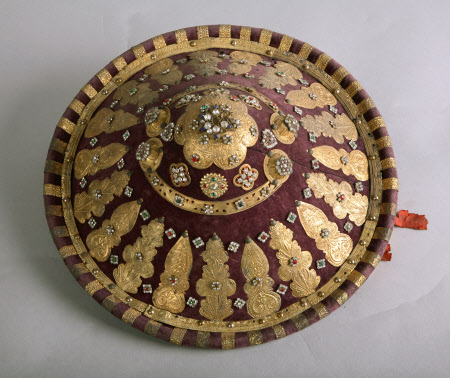Shield
Category
Arms and armour
Date
1930
Materials
Leather, metal, velvet, stone
Measurements
375 mm (Diameter)
Place of origin
Ethiopia
Order this imageCollection
Dunham Massey, Cheshire
NT 933686
Caption
This highly decorated ceremonial shield made in Ethiopia (formerly known as Abyssinia) was a gift from the Crown Prince Asfaw Wossen (1916-97), son of His Majesty Haile Selassie I (1892–1975), to Roger Grey, 10th Earl of Stamford (1896–1976), the owner of Dunham Massey in Cheshire. Lord Stamford was involved in the League of Nations (formed after the First World War to resolve international disputes) and was alarmed by the rise of fascism, particularly in Italy. When Selassie made an address to the League detailing the oppression of Abyssinia at the hands of the Italian government, Lord Stamford invited him to Dunham, and a long friendship ensued. Ethiopian shields were symbols of power and prestige, and often given as gifts to Western dignitaries. This example (given in 1944) is covered in purple velvet, a colour associated with royalty, decorated in gemstones and delicately worked with gold floral motifs and crosses to reference the Coptic Christian faith. The gift was treasured, and each year on Selassie’s birthday the Ethiopian flag is flown at Dunham.
Summary
Ethiopian ceremonial shield, 20th century. The shield is covered with purple cotton velvet, metal gold repoussé plating with decorative floral motifs and crosses. The surface has faceted stones in green, red and white (probably glass), structured, glued and tacked. The inner face and the handle are covered with dark red leather. The handle has a loop of red leather. Given by Crown Prince Asfaw Wossen to Roger Grey 10th Earl of Stamford in 1944.
Full description
Highly ornamented shields in Ethiopia (historically known as Abyssinia) were a sign of status and power. Similar shield styles, locally known as gasha (ጋሻ), were often depicted in art as being used in battle to signify one’s courage as a soldier. A decorated shield also had a ceremonial function and was carried in official government or royal processions in recognition of their owner’s rank. In 1936, His Majesty Haile Selassie I (1892-1975) addressed an appeal to the League of Nations, detailing the tragedy that Abyssinia was suffering at the hands of the Italian government. After many trips abroad witnessing the rise of fascism in Italy, Roger Grey, 10th Earl of Stamford (1896-1976) had taken a great interest in the social plight of Abyssinia. Lord Stamford was also an ardent supporter of the League of Nations and sent Selassie an invitation to stay at Dunham Massey. Selassie arrived at Dunham Massey in 1938 accompanied by his son, the Crown Prince Asfaw Wossen (1916-97). What ensued were years of friendship supported by letter writing. The Crown Prince made further visits to Dunham without his father in the following years and sent the ceremonial shield to Lord Stamford in 1944. Similar shields exist in many museum collections and are recurrently described as gifts given by Ethiopian dignitaries to figures of importance around the world as symbols of relationship affirmation.
